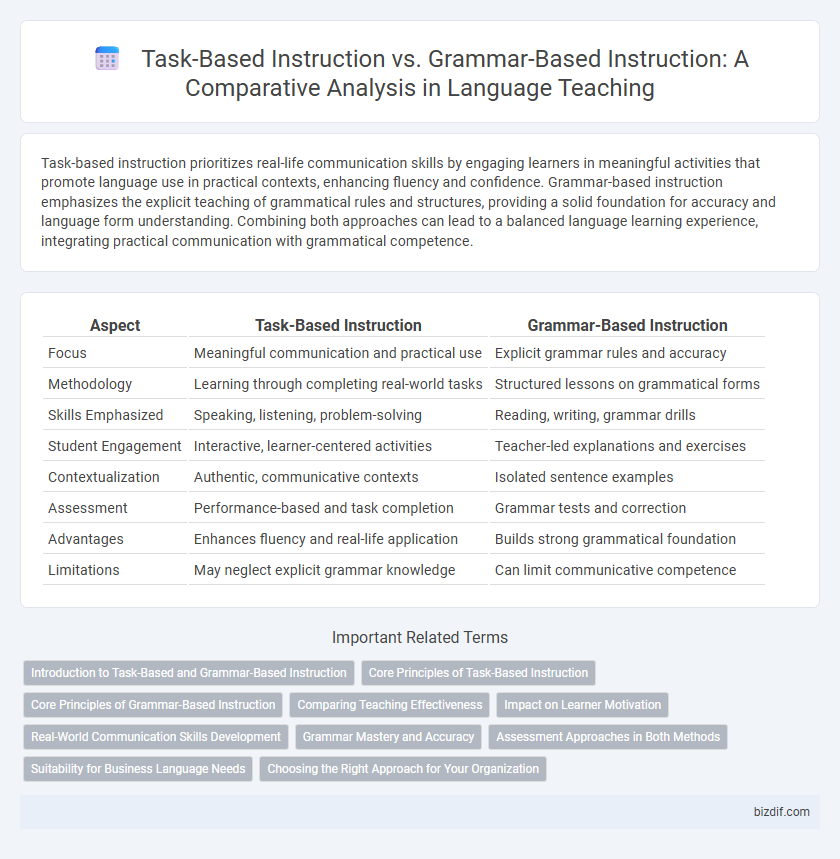Task-based instruction prioritizes real-life communication skills by engaging learners in meaningful activities that promote language use in practical contexts, enhancing fluency and confidence. Grammar-based instruction emphasizes the explicit teaching of grammatical rules and structures, providing a solid foundation for accuracy and language form understanding. Combining both approaches can lead to a balanced language learning experience, integrating practical communication with grammatical competence.
Table of Comparison
| Aspect | Task-Based Instruction | Grammar-Based Instruction |
|---|---|---|
| Focus | Meaningful communication and practical use | Explicit grammar rules and accuracy |
| Methodology | Learning through completing real-world tasks | Structured lessons on grammatical forms |
| Skills Emphasized | Speaking, listening, problem-solving | Reading, writing, grammar drills |
| Student Engagement | Interactive, learner-centered activities | Teacher-led explanations and exercises |
| Contextualization | Authentic, communicative contexts | Isolated sentence examples |
| Assessment | Performance-based and task completion | Grammar tests and correction |
| Advantages | Enhances fluency and real-life application | Builds strong grammatical foundation |
| Limitations | May neglect explicit grammar knowledge | Can limit communicative competence |
Introduction to Task-Based and Grammar-Based Instruction
Task-based instruction emphasizes meaningful communication through real-life tasks to promote language acquisition, while grammar-based instruction centers on explicit teaching of grammatical rules and structures. Research indicates that task-based methods enhance communicative competence by engaging learners in practical language use, whereas grammar-based approaches provide a strong foundation in linguistic accuracy. Both methods contribute to language development, but integrating task-based activities with focused grammar instruction yields optimal learning outcomes.
Core Principles of Task-Based Instruction
Task-based instruction emphasizes meaningful communication through real-world tasks, promoting learner engagement and practical language use. It centers on completing specific tasks that foster language acquisition naturally rather than focusing solely on explicit grammar rules. This approach encourages fluency and problem-solving skills by integrating language learning with authentic activities and interaction.
Core Principles of Grammar-Based Instruction
Grammar-based instruction centers on explicit teaching of grammatical rules and structures, emphasizing accuracy and form over fluency. It involves systematic presentation, practice, and correction of grammatical elements to build a strong foundational knowledge. This approach prioritizes sentence structure mastery, controlled language use, and error correction to enhance linguistic competence.
Comparing Teaching Effectiveness
Task-based instruction enhances communicative competence by engaging learners in real-world language use, promoting fluency and practical application more effectively than grammar-based instruction. Grammar-based instruction emphasizes accuracy and the systematic understanding of language rules, which benefits learners in structured language environments focused on formal correctness. Studies indicate task-based methods yield higher retention rates and learner motivation, while grammar-focused approaches suit exam preparation and error correction contexts.
Impact on Learner Motivation
Task-based instruction enhances learner motivation by engaging students in meaningful communication and real-world problem-solving, fostering intrinsic interest and practical language use. Grammar-based instruction often leads to lower motivation due to its focus on rote memorization and abstract rules, which can feel disconnected from everyday language application. Studies show that learners exposed to task-based approaches demonstrate higher persistence and positive attitudes toward language learning.
Real-World Communication Skills Development
Task-based instruction prioritizes real-world communication skills by engaging learners in meaningful, practical activities that simulate authentic language use. Grammar-based instruction emphasizes the explicit teaching of language rules, which may limit opportunities for spontaneous communication and contextual language practice. Research indicates task-based methods enhance learners' ability to negotiate meaning and perform functional language tasks effectively in diverse social settings.
Grammar Mastery and Accuracy
Task-based instruction prioritizes practical language use and communication, often promoting fluency over explicit grammar mastery. Grammar-based instruction emphasizes systematic learning of grammatical rules, leading to higher accuracy and precise language use in writing and speaking. Research shows that combining task-based interaction with targeted grammar practice enhances both communicative competence and grammatical accuracy.
Assessment Approaches in Both Methods
Task-based instruction assesses language proficiency through practical communication tasks that simulate real-life situations, emphasizing fluency and the ability to use language contextually. Grammar-based instruction often relies on formal assessments like quizzes and tests that target explicit knowledge of grammatical rules and accuracy. Both approaches evaluate different aspects of language competence, with task-based methods prioritizing functional language use and grammar-based methods focusing on structural correctness.
Suitability for Business Language Needs
Task-based instruction effectively aligns with business language needs by emphasizing practical communication skills and real-life scenarios, which enhance workplace interactions and problem-solving capabilities. Grammar-based instruction, while essential for foundational accuracy, may lack immediate relevance in dynamic business settings where fluency and contextual understanding are prioritized. The emphasis on authentic tasks in task-based methods supports the development of negotiation, presentation, and collaboration skills crucial in professional environments.
Choosing the Right Approach for Your Organization
Task-based instruction emphasizes practical language use through real-world activities, enhancing communicative competence and learner engagement. Grammar-based instruction focuses on systematic understanding of language rules, benefiting organizations aiming for accuracy and foundational skills. Selecting the right approach depends on organizational goals, learner needs, and the desired balance between fluency and accuracy in language proficiency.
Task-based instruction vs grammar-based instruction Infographic

 bizdif.com
bizdif.com